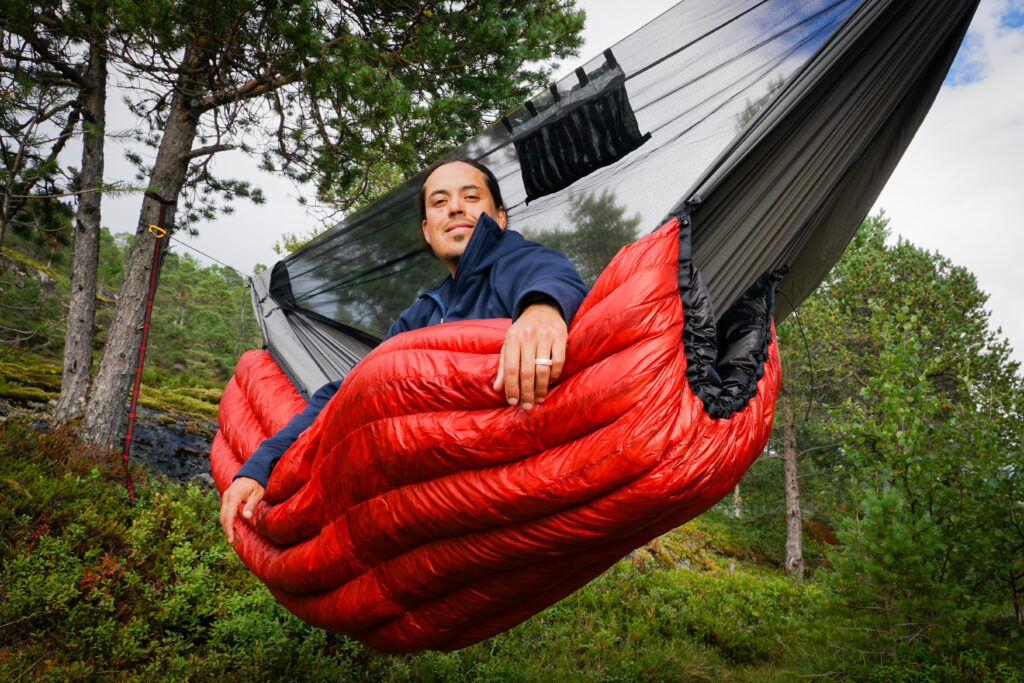5 Essential Hammock Camping Gear Items for a Comfortable Adventure

Hammocks come in a variety of styles, each with its own unique features and benefits. Here’s a quick overview of the main types of hammocks:
Rope Hammocks
Rope hammocks are the classic, traditional style. They are made from woven cotton or polyester ropes and often feature spreader bars at each end to keep the hammock open and flat. Rope hammocks are versatile, comfortable, and durable, making them a popular choice for both indoor and outdoor use.
Quilted Hammocks
Quilted hammocks feature a padded, quilted design that provides extra comfort and support. They are typically made from weather-resistant fabrics and are a great option for use under a patio or gazebo. Quilted hammocks are less flexible than rope hammocks, but offer a more luxurious and cozy lounging experience.
Mayan, Brazilian, and Nicaraguan Hammocks
These hammocks are characterized by their intricate, woven designs and lack of spreader bars. They are lightweight, breathable, and highly adjustable to the user’s body. These hammocks often feature vibrant, colorful patterns and are a popular choice for their unique, artisanal aesthetic.
Camping Hammocks
Designed for outdoor adventures, camping hammocks are lightweight, compact, and easy to set up. They are typically made from durable, weather-resistant materials like nylon or polyester and are a great option for backpacking, hiking, or festivals.
No matter your preference, there’s a hammock out there to suit your needs and style. Consider factors like intended use, comfort, and durability when choosing the perfect hammock for your outdoor oasis.
Hammock Setup and Suspension Systems
Properly setting up and suspending your hammock is crucial for a comfortable and safe outdoor experience. Here’s a quick overview of the key considerations:
Choosing Suspension Systems
Hammock suspension systems come in a variety of materials and designs, each with their own benefits. Common options include polyester straps, Kevlar straps, and spider poly straps. These suspension systems allow you to securely attach your hammock to trees, posts, or other anchor points. When choosing, consider factors like weight, strength, and weather resistance.
Hanging Technique
To hang your hammock, start by wrapping the suspension straps around sturdy anchor points, like tree trunks. Adjust the length of the straps to achieve the desired amount of sag or curve in the hammock. Avoid tying the straps directly to the hammock, as this can damage the fabric over time. Instead, use carabiners or other hardware to connect the straps to the hammock.
Tarp and Shelter
Adding a tarp or other shelter over your hammock can provide protection from the elements. Look for lightweight, water-resistant tarp designs that can be easily set up and adjusted. Proper tarp placement and tensioning is key to keeping you dry and comfortable.
Insulation
For cooler weather, consider adding an under quilt or sleeping pad beneath your hammock to prevent heat loss. Top quilts can also provide additional warmth and comfort.
By carefully selecting and setting up your hammock system, you can ensure a relaxing and enjoyable outdoor experience, no matter the conditions.
Hammock Comfort Features
Hammocks are renowned for their ability to provide a comfortable and relaxing outdoor experience. Here are some of the key features that contribute to their superior comfort:
Ergonomic Design
The unique shape and suspension of hammocks allow them to conform to the natural contours of the body. Many modern hammocks feature an asymmetrical design that supports the spine in a neutral position, reducing pressure points and promoting proper alignment. This ergonomic fit helps alleviate common issues like back pain and stiffness.
Breathability and Air Circulation
Elevated off the ground, hammocks allow for excellent air circulation around the body. This enhanced airflow helps regulate body temperature, keeping you cool and comfortable, even on warm summer nights. The breathable fabrics used in many hammocks further contribute to this cooling effect.
Gentle Rocking Motion
The gentle rocking motion of a properly suspended hammock can have a soothing, almost meditative effect. This rocking motion can help induce relaxation and facilitate deeper, more restful sleep.
Customizable Comfort
Many hammocks offer the ability to adjust the level of sag or tension, allowing you to find the perfect level of comfort. Some models also accommodate additional insulation, such as under quilts or sleeping pads, for added warmth and coziness.
Reduced Pressure Points
Unlike a hard, flat surface, a hammock’s curved shape distributes your body weight evenly, minimizing pressure points and reducing the risk of aches and pains. This makes hammocks an excellent choice for those seeking relief from joint or muscle discomfort.
By combining these comfort-enhancing features, hammocks provide an unparalleled outdoor lounging and sleeping experience. Whether you’re relaxing in the backyard or camping under the stars, a high-quality hammock can elevate your comfort to new heights.
Importance of Weather Protection in Hammock Camping
Weather protection is crucial for a comfortable and enjoyable hammock camping experience. Here are some key points to consider:
Planning Ahead
Before embarking on your camping trip, thoroughly review the weather forecast for your intended location and duration of stay. Prepare accordingly by packing appropriate gear for forecasted conditions, including rain protection, insulation, and extra layers for warmth. Staying vigilant and monitoring changing weather patterns during your camping trip is also essential. Be prepared to bail out and seek shelter if severe weather, such as thunderstorms or high winds, is forecasted. Your safety should always take precedence over completing your camping itinerary.
Choosing the Right
Gear
When it comes to hammock camping in the rain, choosing the right gear can make all the difference. Look for hammocks made from waterproof or water-resistant materials such as nylon or polyester. These materials are not only lightweight and durable but also offer excellent protection against moisture. Additionally, consider hammocks with built-in waterproofing features such as sealed seams and integrated rainflies to provide extra protection from the elements.
Essential Accessories
In addition to a waterproof hammock and tarp, there are several essential accessories that can enhance your rain protection setup. A rain fly is an essential accessory for hammock camping in the rain, providing additional protection from moisture and helping to keep you dry throughout the night. Waterproof gear storage solutions such as dry bags or stuff sacks are also ideal for storing clothes, food, and electronics, ensuring they stay dry and protected from moisture throughout your camping trip.
By choosing the right gear and accessories and taking the time to waterproof your setup, you can enjoy a dry and comfortable hammock camping experience even in the wettest conditions. So don’t let a little rain dampen your outdoor adventures – embrace the elements and make the most of your time in nature.
Types of Tarps
Tarps are versatile tools used to provide protection from the elements, and they come in a variety of types to suit different needs and applications. Here are some of the main types of tarps:
Primary Types of Tarps
- Heavy-Duty Tarps: Heavy-duty tarps are designed to protect stationary items, such as hay, machinery, boats, generators, furniture, or camping materials, when stored outdoors. They are made of durable materials and are often used for long-term protection.
- Truck Tarps: Truck tarps are used to cover and protect loads on flatbed trucks during transportation. They are designed to withstand various types of loads and weather conditions. Some tarps are specifically designed for hauling steel, lumber, or other materials.
Specific Types of Tarps
- Mesh Tarps: Mesh tarps are made of breathable materials that allow air, sunlight, and moisture to pass through. They are commonly used to cover materials like gravel, small rocks, and sand during transportation. They are also used in nurseries to provide sunlight to plants.
- Canvas Tarps: Canvas tarps are made of highly breathable materials that allow air to pass through their individual fibers. They are often used to protect carpets and furniture during indoor painting and to cover fresh vegetables and fruits that are moisture sensitive.
- Poly Tarps: Poly tarps are made of plastic materials called polyethylene, which can be of high or low density. They are lightweight and water-resistant, making them suitable for short-term use. They are often used as truck bed liners and as floor coverings in gyms.
- Vinyl Tarps: Vinyl tarps are thicker and more abrasion-resistant than other types of tarps. They are commonly used as truck bed covers and for emergency shelters.
Each type of tarp has its own unique features and benefits, making them suitable for different applications. Understanding the characteristics of each type helps individuals choose the right tarp for their needs, ensuring durability and protection in various situations.
Hammock Setup Tips for Comfort and Convenience
Properly setting up your hammock is crucial for achieving a comfortable and relaxing outdoor experience. Here are some key tips to keep in mind:
Choose the Right Suspension System
The suspension system you use to hang your hammock can greatly impact its stability and comfort. Look for high-quality straps or ropes that are durable, weather-resistant, and easy to adjust. Avoid tying the hammock directly to the anchor points, as this can damage the fabric over time. Instead, use carabiners or other hardware to connect the suspension to the hammock.
Achieve the Optimal Sag
The amount of sag or curve in your hammock is important for comfort. Aim for a 30-degree angle between the suspension straps and the ground. This creates a gentle, “smiley face” curve that supports your body ergonomically. Avoid stringing the hammock too tightly, as this can lead to an uncomfortable, cocoon-like feeling.
Lay Diagonally
When lying in the hammock, position your body at a slight diagonal angle rather than straight down the center. This helps flatten your body and reduces pressure on your knees and legs. Experiment with different angles to find your sweet spot.
Raise the Foot End
Consider hanging the foot end of your hammock slightly higher than the head end, around 8-10 inches. This can help prevent you from sliding towards the center and maintain a comfortable, neutral spinal alignment.
Add
Insulation
and Weather Protection
Depending on the conditions, you may want to incorporate additional accessories like an under quilt, sleeping pad, or tarp. These can provide crucial warmth and shelter, enhancing your overall comfort and enjoyment.
By following these setup tips, you can ensure a cozy, relaxing, and hassle-free hammock camping experience, no matter the weather or terrain.
Insulation
Needs for Hammock Camping
Staying warm and comfortable is a crucial aspect of hammock camping, especially in colder weather conditions. Proper insulation is key to ensuring a cozy and enjoyable outdoor experience.
Understanding Convective Cooling
One of the primary challenges of hammock camping is the issue of convective cooling. When you’re suspended in a hammock, air can circulate freely around your body, causing heat loss. This is where insulation becomes essential to maintain your body temperature and prevent shivering.
Layering for Warmth
The most effective way to stay warm in a hammock is through a layered insulation system. This typically involves using an underquilt, which hangs beneath the hammock to insulate your back and sides, and a top quilt or sleeping bag to cover your upper body. These insulation layers work together to trap your body heat and prevent it from escaping.
Choosing the Right
Insulation
The type of insulation you choose will depend on the climate and weather conditions you’ll be facing. Synthetic insulation, such as Climashield, is a popular choice as it retains warmth even when wet. Down insulation, on the other hand, offers superior warmth-to-weight ratio but can lose its insulating properties when damp.
Preparing for Temperature Fluctuations
It’s important to be prepared for temperature fluctuations throughout the night. Bring additional layers, such as a warm hat, gloves, and socks, to ensure you can adjust your insulation as needed. Monitoring the weather forecast and packing accordingly can also help you stay comfortable.
By understanding your insulation needs and incorporating the right layering system, you can enjoy a cozy and restful night’s sleep in your hammock, even in the chilliest of conditions.
Types of
Insulation
for Hammock Camping
Staying warm and comfortable is crucial when hammock camping, especially in colder weather conditions. There are several types of insulation options to consider to keep you cozy throughout the night.
Underquilts
Underquilts
are one of the most popular and effective forms of insulation for hammock camping. These specialized quilts hang beneath the hammock, providing insulation and a wind barrier for your back and sides.
Underquilts
come in a variety of materials, including down and synthetic insulation, each with their own unique benefits.
Sleeping Pads
Traditional sleeping pads can also be used for insulation in a hammock. These can be placed directly in the hammock beneath you. However, sleeping pads may not provide as much coverage or insulation as an underquilt, and they can also create pressure points and disrupt the hammock’s comfort.
Closed-Cell Foam Pads
Closed-cell foam pads are a budget-friendly insulation option for hammock camping. These lightweight pads can be placed in the hammock to provide a barrier against conductive heat loss. While effective, closed-cell foam can sometimes wrinkle or create condensation issues.
Sleeping Bags
Using a sleeping bag in a hammock is a simple and inexpensive solution, but it may not be the most effective. Sleeping bags can bunch up and leave gaps where heat can escape. They also tend to compress under your body weight, reducing their insulating properties.
Reflective
Insulation
Reflective
insulation, such as mylar or radiant barrier materials, can be used in conjunction with other insulation methods. These materials help reflect body heat back to you, enhancing the overall warmth of your setup.
By understanding the various insulation options and their unique characteristics, you can choose the right combination to keep you warm and comfortable during your hammock camping adventures.
The Necessity of Bug Protection for Hammock Camping
When it comes to hammock camping, bug protection is a crucial aspect of ensuring a comfortable and enjoyable experience. Mosquitoes, gnats, and other insects can be a significant nuisance, disrupting your sleep and overall relaxation. Bug protection is essential for several reasons:
Health Risks
Mosquitoes can transmit diseases such as malaria, dengue fever, and West Nile Virus. These diseases can have serious health consequences, making bug protection a vital aspect of hammock camping. By using a bug net or other protective measures, you can significantly reduce the risk of contracting these diseases.
Comfort and Relaxation
Bug protection also enhances the overall comfort and relaxation of hammock camping. When you are free from the constant annoyance of bugs, you can fully appreciate the peacefulness of nature. Bug protection allows you to enjoy the serenity of your surroundings without the distraction of biting insects.
Practicality
Bug protection is also practical for hammock camping. It ensures that you can enjoy your hammock without the constant need to swat at bugs or apply insect repellents. This allows you to focus on other aspects of your camping experience, such as enjoying the scenery or engaging in outdoor activities.
Options for Bug Protection
There are several options available for bug protection in hammocks. These include full-net hammocks, half-net hammocks, and bug shields. Each of these options offers different levels of protection and convenience, allowing you to choose the one that best suits your needs.
Bug protection is a necessity for hammock camping. It ensures your health and comfort, enhances your overall experience, and provides practical benefits. By investing in a bug net or other protective measures, you can enjoy a peaceful and enjoyable hammock camping experience.
You may also be interested in: Beyond the Tent: 5 Reasons Why Hammock Camping Will Change
Embark on your next adventure with Hammock Gear’s custom quilts! Tailor your comfort for the wild – choose your style, warmth, and size to craft your perfect eco-friendly outdoor companion, or grab a complete ultralight kit. Made in the USA for unparalleled quality and comfort. Trusted since 2009. Shop Now and tap into a community of nature lovers!⭐
Related Posts
The Best Camping Hammocks of 2024 – A Buyer’s Guide by Hammock Gear
A good camping hammock can completely transform how you experience…
Can Napping Hurt You? Unveiling the Pros & Cons of Daily Zzz’s
Napping, the act of taking a brief sleep during the…


